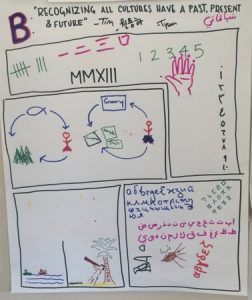As wikipedia states the, “Authentic assessment is the measurement of intellectual accomplishments that are worthwhile, significant, and meaningful.” They go on to say those qualities are in comparison to standardized testing. I couldn’t agree more. I can’t think of an instance that I have used anything from my high school standardized testing career that I revisited in the real world. One of my favorite components of an authentic assessment is that they can be created in collaboration with the students. This gives students a sense of ownership with the class.
Creating an authentic assessment starts by asking the question – what should the students be able to do? To apply authenticity students should be able to mirror real tasks or problem solving skills that may be required from them outside of the school. The good authentic assessment or assessments in general should involve an act of learning. An authentic assessment will in many cases ask students to require a judgement toward the quality of something making it subjective in nature, in essence to get the student making opinions about the subject matter to display their knowledge about it.
Some other aspects, other than the real world applicability, that authentic assessments should have are: backwards design ie-creating them before the curriculum, creating rubrics to ensure rigor, gets students using critical thinking skills, they help students self-assess their learning, they measure how they think not what they remember, and perhaps most important they engage students because they are based on content that students have genuine interest in.

 mbol down. As far as the evolutionary evolution of the “el numero” goes you got the caveman’s chicken scratches, and then the Romans counting with letters because they drank so much wine, then finally the Arabs are like “let us not stand in the face of adversity by misrepresenting math with literature. Let us create the number!” and so it became its own universal language, “e pluribus nerdum”. The next portion of our work displays the arrogant “smart man”, fully equipped with his horse blinders, claims he came up with the modern day revolutionary idea of sustainability while half of the world’s cultures have been practicing that since the dawn of time, otherwise known as the ice age, which, isn’t the ice age anymore because it took too long to come up with the dang idea. Next, we have a beautiful rendition of early astronomy from two separate cultures, roughly at the same time, 12,000 miles away from each other. One could land a whole colony of people on an atom across 7000 miles of ocean by using the stars, whilst the other named almost every star in the modern sky. The final section in our work of art has to do with letters and stuff but I am a math/science guy.
mbol down. As far as the evolutionary evolution of the “el numero” goes you got the caveman’s chicken scratches, and then the Romans counting with letters because they drank so much wine, then finally the Arabs are like “let us not stand in the face of adversity by misrepresenting math with literature. Let us create the number!” and so it became its own universal language, “e pluribus nerdum”. The next portion of our work displays the arrogant “smart man”, fully equipped with his horse blinders, claims he came up with the modern day revolutionary idea of sustainability while half of the world’s cultures have been practicing that since the dawn of time, otherwise known as the ice age, which, isn’t the ice age anymore because it took too long to come up with the dang idea. Next, we have a beautiful rendition of early astronomy from two separate cultures, roughly at the same time, 12,000 miles away from each other. One could land a whole colony of people on an atom across 7000 miles of ocean by using the stars, whilst the other named almost every star in the modern sky. The final section in our work of art has to do with letters and stuff but I am a math/science guy.
